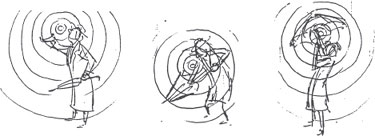While animating, you have the advantage of flipping the drawing you are working on with the previous extreme, to develop the full effect of an action:

(Glance back and forth from one drawing to another and you get the effect.) This effect of motion lays open to view the main, or primary, action. Everything else becomes a secondary action in some degree or another. An animator never allows a secondary action to take precedence over the primary action. You might think of the primary action as the center of interest while all other actions diminish in concentric rings of importance:

If the viewer’s eye is pulled to some activity somewhere far from the center of interest then this becomes a conflict of interest, and the viewer has to fight his way along the story, instead of being swept along a well-focused, well-planned, easy-to-read action.
While sketching from a model there is a tendency to think of the pose as a still life. For the sake of animation study, think of the pose rather as a part (or extreme) of an action. You have no previous extreme to flip from but you do have that sense of motion to give you the feel of what the body went through to get to that pose. This helps you to establish the center of interest and to feature or stress the important action. In our class, time and again there has been a pose where the model, having brought a prop, has built a pose around the prop; for instance, opening an umbrella. Last week, 5 minutes into the sketching, there were, out of 17 drawings, only 3 or 4 umbrellas sketched in.
The “first impression” should have been “woman opening umbrella.” The center of interest! There should have been an overwhelming obsession to produce a drawing that says “woman opening an umbrella.”
Even after accepting the fact of the center of interest, the battle has just begun, and the shortest route to victory is the use of all the rules of drawing: perspective, tension, angles, rhythm, squash and stretch, etc. Every single line should support the theme and help accent the thrust of the action. The feeling of motion, that is the building up of physical action to reach that climax of the pose, can be conjured up mentally and will serve as a previous animation extreme to “flip” from to reach a dynamic extreme drawing — one that says, for instance, “woman opening umbrella.”
But whatever the prop or whatever the action, there is a story to be told, and a prop definitely suggests a theme. A story sketch man usually has only one drawing to describe a scene — he must choose one that will illustrate the story point. If an umbrella is involved, you can be sure he will construct a sketch featuring an umbrella. The story men and the director could care less about how much the story sketch man knows about anatomy or detail drawing, as long as the story point is getting across.
There comes a time in an author’s career when he transcends the obsession to get the proper amount of verbs and adjectives and prepositions into a sentence and concentrates on telling his story in an interesting, absorbing, stimulating, arresting, striking, attractive, appealing, and entertaining way.
The artist (animator), (you) have the same raison d’être.

